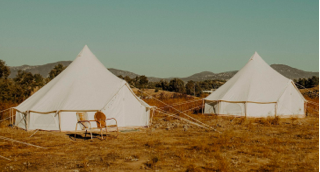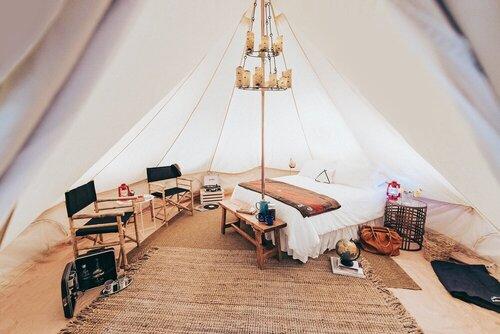PAY NO SALES TAX
FREE GROUND TARP WITH BELL TENT PURCHASE
Free Shipping

Pay No Sales Tax
30-Month Warranty
PAY NO SALES TAX
FREE GROUND TARP WITH BELL TENT PURCHASE
Tents
Shop


The LiT List
Glamping & Camping Ideas + Resources
Choosing an Outfitter and Hunting Tent That's Right For You
6 min read
Long-term camping requires a durable outfitter tent. Whether you need to set up your deer camp for your hunting group or simply appreciate winter camping, an outfitter tent is the perfect structure. Not only do these tent styles allow campers and hunters to feel more at home, but they also provide the semi-permanent tent-style shelter needed for weeks, months, and extended periods of time. But just how do you choose an outfitter tent? In this guide, we break down the must-haves and things to consider.
Choosing an Outfitter Group Tent Size

For long-term stays, consider a spacious outfitter tent. Just how large you need your outfitter tent to be is up to you. But just remember that the capacity of your outfitter tent should accommodate sleeping arrangements for the number of adults and children staying, as well as your gear and any camp furniture.
In addition, an outfitter tent should offer extra height compared to a typical dome tent. Vertical walls and even a center pole give the interior headspace needed to stand comfortably and move about.
Essentially, you want to give everyone some extra breathing room inside the living quarters.
To decide on an outfitter tent size, consider the following:
- Camp Cots: For long-term stays, we highly recommend upgrading to camp cots, instead of sleeping on the floor. Extra space beneath the cot offers extra storage space for gear and more. Plus, it’s simply more supportive and comfy.
- Sitting Areas: Arrange a small sitting area inside your outfitter tent. With a few camp chairs and a folding table, it can double as a dining space and a game table, especially when it’s cold or rainy outside.
- Wood Stove: If you plan to pitch your outfitter tent in colder temperatures, a wood stove is a must (more on that later). Just remember to accommodate for a safe perimeter around the wood stove and pipe.
- Gear: Last but not least is gear. Whether that’s a per-person rucksack, camp games and entertainment for the kids, or a scent-proof bag of hunting equipment, you know best what kind of camp gear you plan to tow.
As you’re probably aware, standard tent sizes typically indicate room for bodies alone, without much wiggle room for moving about, gear, camp chairs, cots, et cetera. However, Life inTents offers realistic sizes for our canvas outfitter tents. Here’s an outfitter tent comparison guide to get an idea.
Tent Materials: Canvas, Frames and More

Outfitter tents tend to be semi-permanent structures. Left pitched in the woods, in the snow, or under a beating hot sun, your outfitter tent needs to withstand the elements in multiple ways.
When choosing an outfitter tent, make sure to select one with durable canvas and a sturdy frame to keep it standing.
Outfitter Fabric Tent Materials
Skip the nylon tents. Outfitter tents need to be canvas or a poly-cotton blend, plain and simple.
More than that, your canvas outfitter tent needs to be waterproof, mold-resistant and fire-resistant. Especially if you plan to leave your outfitter tent up for months at a time.
Here at Life inTents, our outfitter tents are offered in a high-quality cotton material – DoekTec.
Our DoekTec cotton canvas offers many features:
- Extra Thick Weight: At 11.5 ounces per square yard (390 GMS), it’s the thickest cotton on the market, making your canvas outfitter tent stronger and more insulative.
- Dye-free Cotton: A cream white canvas not only looks beautiful, but reflects the sun’s rays to keep your outfitter tent cooler inside.
- Waterproof Treatment: Most outfitter tents are water-resistant, but we went a step further, adding a waterproofing agent that sheds rain, rolling it right off. We recommend retreating after extended use, but they’re ready to do as is!
- Mildew Resistance: Outfitter tents pitched for extended periods of time will tend to grow mold and mildew. But Life inTents took extra steps to give our outfitter tents extra defense to discourage mold and mildew from sporing in the first place. We even published the results!
- Fire Resistance: Whether you install a wood stove or use other heating elements, be sure to choose an outfitter tent made of fire-resistant cotton canvas. DoekTec cotton offers aCPAI-84 certification.
- Double Stitching: Thick DoekTec cotton aside, double-stitched seams make your outfitter tent strong and more secure, ensuring it will last for years to come – even generations.
The Tent Frame and Stakes
Most outfitter tent structures are held up by aluminum and/or galvanized steel frames. Aluminum offers a lightweight advantage, whereas galvanized steel lends strength and rigidity. An aluminum outfitter tent frame means it’s easier to transport, but you might want that galvanized steel setup when pitched in a windstorm or falling snow.
Life inTent outfitter tents offer a combination of these metal types, using each where it matters most:
- Poles: The center pole and door poles are made of galvanized steel coated in brass. This gives your outfitter tent the structural integrity it needs at all times.
- Stakes: Rebar stakes secure the outfitter tent along the outside. These stakes are so tough and secure that they can penetrate rock beds!
- Outer Wall Poles: Unlike many canvas tent bands, many of Life inTent’s outfitter tents come with outer wall poles (made of aluminum) that offer additional support. These outer wall poles ensure a taught canvas wall that doesn’t droop or swag, keeping leaves, snow, and rain from gathering.
-
Guy Lines: Stretched tight with the reflective guy line ropes (complete with easy-to-adjust aluminum sliders), your outfitter tent is ready!
- Canvas Storage Bag: A tent and all of the above components being able to pack down into s single bag. Making it easier to transport.
When all is said and done and your structure is properly pitched, Life inTent outfitter tents can withstand wind gusts up to 50 mph.

Additional Outfitter Accessories for the Tent
Your outfitter tent capacity, canvas material, and frame are three main considerations to make when choosing your structure. However, when selecting the best outfitter tent for your family or excursion, take a look at some of the extra bells and whistles that the brand offers.
Here are a few extra features that can elevate your outfitter tent.
Wood Stove For The Tent
Even if you don’t think you’ll need a tent wood stove, it pays to have the option. Choose an hunting tent that is wood stove compatible, at the very least. You can always choose to install a wood stove and jack later, but be sure to choose an outfitter tent with fire-retardant canvas. You should also consider picking up extra accessories like a fireproof mat to protect the floors.
Many tents we offer come with a built-in ceiling stove jack for adding a wood-burning stove. It comes at 4 inches but can be adjusted to fit a 6-inch stove pipe. This means installing a wood stove in your outfitter tent has never been easier!
Interior Tent Ventilation
Ventilation is necessary for any tent. But it’s crucial with canvas tents, especially to prevent condensation and moisture, which can lead to mold and mildew. While our outfitter tents are treated for mildew resistance, ventilation is still critical in maintaining the life of the tent. Plus, ventilation simply offers a cross-breeze. In summer or winter, eventually, your tent needs to air (preferably while keeping bugs out).
So when choosing an outfitter tent, select one with mesh-screen windows. Even better if there’s a mesh-screen door. And look for ceiling vents.
Life inTents outfitter tents offer windows, doors, and even a 360-degree double sidewall that can unzip and roll up. Each is protected with mesh to keep out bugs and critters.
Waterproof Tent Floor
While most of your outfitter tent should be cotton or a poly-cotton blend, make sure it has a waterproof floor – we can’t stress it enough! Whether you use your outfitter tent for camping or hunting, a wipeable vinyl footprint will ensure bugs stay out and the tent stays insulated. Plus, it adds an extra layer of protection from ground moisture.
Our outfitter tents offer a 19 oz PVC floor footprint that can be easily cleaned and keeps out moisture. (It’s also fully removable!)
Fly Cover
Of course, if you want to add extra protection, a fly cover or rainfly is a must. It adds an extra layer of protection against the elements, including UV rays and allows snow to more easily slide off. A fly tarp also helps to reduce condensation.
While it may seem frivolous, a fly tarp can take the brunt of many mishaps, saving the outfitter tent and making it last exponentially. Ultimately, it reduces your tent maintenance.
One note to mention: Most fly tarps are not fire-resistant, which means some stove jacks won’t safely work. If you still want a wood stove, there is an option – exit the stove jack through the canvas side wall!
Why Choose A Canvas Outfitter Tent?
As a canvas wall tent, outfitter tents bring a ton of benefits to campers. But not every camper needs an outfitter tent.
Remember: For the most part, outfitter tents are ideal for those looking to head out into the wilderness for long excursions. Not necessarily a weekend family camping trip. While you can use an outfitter tent for multiple purposes like glamping or even a home office, fitting a canvas tent with a wood stove and generally prepping it as a long-term residence is what makes it a true outfitter tent.
So learn the pros and cons of canvas wall tents and tips to protect your tent for long-term use.
But if you are indeed wanting an outfitter tent and need to deck it out, Check out these posts:
Choosing an outfitter tent for your deer camp or hunting camp?
Check out these Deer Camp Essentials and these Successful Hunting Camp Tips.
Need a more stable ground surface for your outfitter tent?
Learn how to Build a Wood Platform Deck that offers elevation and extra support.
Related Resources

THE LIT LIST 5 min read
The 7 C's of Camping and Glamping: A Code of Ethics
Ever heard of the 7 C’s of Camping? What about the 7 C's of Glamping? Among the countless camping aLearn the Camper's Code of Ethics: The 7 C's of Camping. Discover how this set of rules is still used today, even at glamping properties. And begin to practice them to be a better camper and guest.

THE LIT LIST 19 min read 4 Comments
How To Start a Glamping Business (and Create a Perfect Glampsite)
Glamping has grown from a niche trend into a serious hospitality segment, with guests willing to pa Popular Blogs
Camping Gift Ideas for People Who Have Everything
The Best Portable Tent Heaters - Ways To Heat A Canvas Tent
Glamping in Northern California: 8 Luxury Sites
Waterproofing A Canvas Tent - Retreating Canvas
33 Camping Quotes to Inspire Your Next Adventure
What Is Glamping? Origins, Definition, Destinations & More
10 Tips for Staying Warm While Winter Camping
How to Maintain and Clean a Bell Tent
Essential Family Camping Checklist: What to Pack [PRINTABLE]
Backyard Glamping Checklist for an Unforgettable DIY Glampsite
Popular Products
Subscribe
Sign up to get the latest on sales, new releases and tips
BECOME AN INSIDER
We’ll periodically share inspiration, bell tent releases, special offers, and event notifications with ya.



